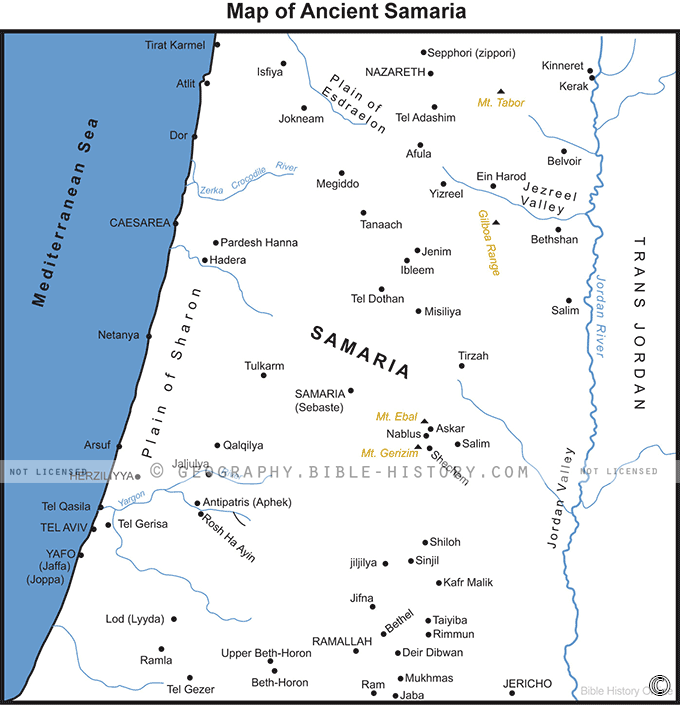
The "Map of Ancient Samaria" takes you on a captivating journey back in time to explore the historical and cultural riches of this significant region in the ancient world. Samaria, nestled between Judea and Galilee, holds a prominent place in both biblical and secular history.
Geographical Insights
This map offers a comprehensive view of the ancient land of Samaria, presenting its boundaries, cities, topography, and key features. It provides a window into the geographical context that shaped the lives of the Samaritans and their interactions with neighboring regions.
Historical Significance
Samaria has a rich and complex history that includes biblical narratives, archaeological discoveries, and cultural interactions. It was the capital of the northern kingdom of Israel and a place where significant events unfolded in both the Old and New Testaments.
Key Sites and Landmarks
As you explore this map, you'll encounter prominent locations within ancient Samaria, such as the city of Shechem (modern-day Nablus), where Abraham first entered the Promised Land, and the well-known encounter between Jesus and the Samaritan woman at Jacob's Well.
Educational and Archaeological Value
For scholars, history enthusiasts, and students of the Bible, this map serves as a valuable educational tool. It provides insights into the archaeological sites, ancient routes, and historical context of Samaria, enhancing the understanding of this region's importance.
Spiritual and Cultural Exploration
For those interested in the biblical narrative, Samaria is a place where important stories from the Old and New Testaments converged. This map invites you to delve into the cultural and spiritual dimensions of Samaria's history and its relevance to the biblical narrative.
The "Map of Ancient Samaria" offers a unique opportunity to explore the heartland of an ancient kingdom. It allows you to connect with the stories and heritage of this region, whether from a historical, archaeological, or spiritual perspective, and to appreciate its enduring significance in the annals of human history.
Blank Topo Map of The World
Abraham’s Journey
The Captivity of Judah (586-516 B.C.)
The Fall of Judah 586 B.C.
The Northern Kingdom of Israel
The Southern Kingdom of Judah
The Divided Kingdom
The Fertile Crescent
Ur of the Chaldees
Shechem in Old Testament Times
Prophets, Kings, and Nations
Jesus Last Passover
New Testament Israel
New Testament Places
Old Testament Israel
Provinces of the Roman Empire
Israel during David’s Kingdom
David’s Kingdom
Cities of the New Testament 4
Cities of the New Testament 3
Cities of the New Testament 2
Mediterranean Sea
Cities of the New Testament
First Century Jerusalem
Empire of David and Solomon
David’s Kingdom
Israel Under Rehoboam
Ophir and Tarshish
The Period of the Kings
Ramoth Gilead
Samaria
Solomon’s Temple
Zarephath and MT Carmel
Jabesh Gilead and Tribes
Judah in the Time of David
Kingdom of Saul
Kirjath Jearim
Michmash
Mount Gilboa in the Time of David
Nob Davids Flight
Shiloh
Israel and Judah
Assyrian Empire Under Esarhaddon
Assyrian Empire Under Sennacherib
Captivity of 10 Tribes
Events in 2 Kings
The Khabur River
Israel and Syria
Captives From Judah
Kingdom of Jeroboam
Mesha’s Kingdom
Pharaoh Necho Battles King Josiah at Megiddo
Babylonian, Mede and Persian Empires
Samaria and Nearby Territories
Syria at its Height
Hebron
Mahanaim
1949 Map of Israel With Boundaries
First & Second Journeys of Paul
Journeys of the Apostles
Paul’s Third Missionary Journey
Saul’s Journey to Damascus and Arabia
Paul’s Final Visits
Paul’s 1st Missionary Journey
Paul’s 2nd Missionary Journey
Paul’s 3rd Missionary Journey
Paul’s Voyage to Rome
Phillip Journeys to Samaria and Gaza
Judah at the Time of Amos
Empire of Alexander the Great
Israel Under the Maccabees
Galilee During Maccabees
Idumea Intertestamental Period
Kingdom of the Ptolemies
Kingdom of the Seleucids
Ptolemaic Egypt Seleucid Asia
The Roman World
Kingdom of Ptolemies and Seleucids
The World During the 6TH Century BC
Mount Horeb
The Red Sea
The Exodus
Ezra’s Journey to Restore Jerusalem
Israel and Judah During Hosea’s Time
The Ancient World
Canaan During the Time of Abraham
The City of Shechem
Supposed Location of the Garden of Eden
The Land of Israel in Genesis
The Jordan River
The Kingdom of Nimrod
Mount Ararat and Mesopotamia
The Descendants
Sodom and Gomorrah
The Kingdom of Egypt
The Hamites
The Kingdom of the Hittites
Ur of the Chaldees
Judah at the Time of Haggai
Jesus Passes Through Samaria
